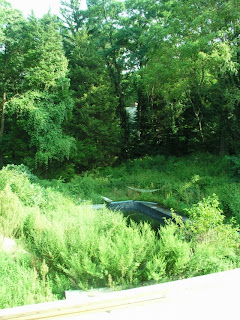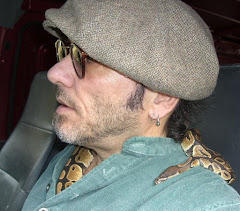Schulter Kerdi ~ photos are clickable~
I thought I’d talk about one of the new innovative products that I’ve been researching and using of late called The Kerdi System for tile installation.
of late called The Kerdi System for tile installation.
Exactly what is Kerdi?
Kerdi is a polyethylene, waterproofing membrane, which is covered on both sides with an anchoring fleece. It is suitable for waterproofing in conjunction with tiled surfaces on walls and floors.
And why do I use it? And why do I think you should as well?
The biggest complaint about tile jobs in a wet area such as a shower is leaks…OK…lets assume we have no leaks…There is another issue we all have to deal with no mater how well the tile job was performed…and that’s mold and mildew. Something that’s almost unavoidable…until now!
The Schluter company has come out with the Kerdi product not all that long ago.I asked numerous people about it and the response I kept getting was that it’s “to water proof your wet areas to avoid leaks” . Well, that answer wasn’t really good enough for me. My tile jobs have “never” leaked because I pay close attention to my work. What I couldn’t avoid however was mold and mildew eventually poking its dirty little head through the grout joints. Mold is ugly and nasty and even smells bad but worse than that it harbors disease.
. Well, that answer wasn’t really good enough for me. My tile jobs have “never” leaked because I pay close attention to my work. What I couldn’t avoid however was mold and mildew eventually poking its dirty little head through the grout joints. Mold is ugly and nasty and even smells bad but worse than that it harbors disease.
In the past a good tile installation would consist of your stud walls and attached to that I would install a poly vapor barrier. Over the vapor barrier (sheets of plastic) I would attach my CBU (cement board units). I would then thinset (cement adhesive) all seams and then begin my tile installation.
The thing about cement boards is that they won’t decompose like drywall but they “will” absorb water/moisture and hold it there for extended periods of time….hence our ugly friends mold and mildew eventually and inevitably visit us.
So how do we help avoid this?
We install the Kerdi fabric to the walls to be tiled. No moisture can get behind this fabric/membrane so any moisture that gets behind our tile will dry out quickly.Kerdi fabric is installed similarly to wallpaper except the glue is our thinset/cement.Kerdi is waterproof therefore we can attach this membrane directly to sheetrock if we so desire or….continue to use a CBU (our cement board units) and cover that with the Kerdi membrane.
except the glue is our thinset/cement.Kerdi is waterproof therefore we can attach this membrane directly to sheetrock if we so desire or….continue to use a CBU (our cement board units) and cover that with the Kerdi membrane.
So what do we have then…Cement boards, cement thinset, kerdi fabric and finally cement thinset to our tiles to the fabric. Think about that..Its pretty much bullet…I meanwater“PROOF”!
How long does it take to install?
Typically you can figure in a shower stall it takes a good part of the day after everything is said and done…..
And the cost?
The cost of labor is typically a little more than the kerdi materials themselves. It all depends how big your wet area are.
All photos are of a kerdi job I did in my own home
 ~
~
I thought I’d talk about one of the new innovative products that I’ve been researching and using
Exactly what is Kerdi?
Kerdi is a polyethylene, waterproofing membrane, which is covered on both sides with an anchoring fleece. It is suitable for waterproofing in conjunction with tiled surfaces on walls and floors.
And why do I use it? And why do I think you should as well?
The biggest complaint about tile jobs in a wet area such as a shower is leaks…OK…lets assume we have no leaks…There is another issue we all have to deal with no mater how well the tile job was performed…and that’s mold and mildew. Something that’s almost unavoidable…until now!
The Schluter company has come out with the Kerdi product not all that long ago.I asked numerous people about it and the response I kept getting was that it’s “to water proof your wet areas to avoid leaks”
In the past a good tile installation would consist of your stud walls and attached to that I would install a poly vapor barrier. Over the vapor barrier (sheets of plastic) I would attach my CBU (cement board units). I would then thinset (cement adhesive) all seams and then begin my tile installation.
The thing about cement boards is that they won’t decompose like drywall but they “will” absorb water/moisture and hold it there for extended periods of time….hence our ugly friends mold and mildew eventually and inevitably visit us.
So how do we help avoid this?
We install the Kerdi fabric to the walls to be tiled. No moisture can get behind this fabric/membrane so any moisture that gets behind our tile will dry out quickly.Kerdi fabric is installed similarly to wallpaper
So what do we have then…Cement boards, cement thinset, kerdi fabric and finally cement thinset to our tiles to the fabric. Think about that..Its pretty much bullet…I meanwater“PROOF”!
How long does it take to install?
Typically you can figure in a shower stall it takes a good part of the day after everything is said and done…..
And the cost?
The cost of labor is typically a little more than the kerdi materials themselves. It all depends how big your wet area are.
All photos are of a kerdi job I did in my own home
 Am I an impractical carpenter?
Am I an impractical carpenter?Impractical means 'not advisable to put into practice' while impracticable means 'not capable of being put into practice'; impractical or unpractical is something that can be done but isn't worth doing while impracticable means it can't be done at all which means there's hope for me after all.What I've learned through-out my years in this current lifetime is that I can choose what's unrealistic. Some call this reaching for the stars, while some call it..... To me this means taking a sows ear and turning it into a silk purse....as 'impractical as that may sound'.There have been projects set before me that to most......... in my position, would have walked away from...and this for me, is very hard to do. I too often feel more of the love than the pain.......... when I get the vision.I feel the dream deep inside...I envision it...inhale deeply, exhale, and step off the edge of the ledge as I so del icately put it. This is the point where I see the vision more clearly as I start weeding things out (so to speak). One picks their tools wisely for the vision at hand. Weeding requires much patience, as any good farmer will tell you. It takes dedication to the farm, to the land and to the air we breath. The soil can be worked when the rain clouds clear and then...the vision becomes more clear. We see the tools we need to make the vision a reality. We soon see if practicality is what embodies the mother of invention....or not. You can feel it, you can taste it and then you can see it. It transcends life.It then becomes a part of you. I think this is what separates a job from the craft. The word "just" is never a part of your vocabulary anymore. The vision becomes a part of your life style. It becomes a project that is a part of your life. It becomes your work. Your dharma if you will. It brings you strength. It empowers you. It feeds you. You're fertilizing the soils. You're growing the vision.There really is no project I find beneath me. Whatever it is I do, large project or small I do with an awareness..and the awareness is that it a
icately put it. This is the point where I see the vision more clearly as I start weeding things out (so to speak). One picks their tools wisely for the vision at hand. Weeding requires much patience, as any good farmer will tell you. It takes dedication to the farm, to the land and to the air we breath. The soil can be worked when the rain clouds clear and then...the vision becomes more clear. We see the tools we need to make the vision a reality. We soon see if practicality is what embodies the mother of invention....or not. You can feel it, you can taste it and then you can see it. It transcends life.It then becomes a part of you. I think this is what separates a job from the craft. The word "just" is never a part of your vocabulary anymore. The vision becomes a part of your life style. It becomes a project that is a part of your life. It becomes your work. Your dharma if you will. It brings you strength. It empowers you. It feeds you. You're fertilizing the soils. You're growing the vision.There really is no project I find beneath me. Whatever it is I do, large project or small I do with an awareness..and the awareness is that it a ll adds up to the bigger picture. It's the foundation the eyes don't see that supports the monument within~
ll adds up to the bigger picture. It's the foundation the eyes don't see that supports the monument within~
 ll adds up to the bigger picture. It's the foundation the eyes don't see that supports the monument within~
ll adds up to the bigger picture. It's the foundation the eyes don't see that supports the monument within~"Three photos are of the same property
as I brought the house and the
property into a transformation
I envisioned"http://www.vifp.com/p/panorama.php?Branded=0&agent=8628&mls=1987084&r=1 <--You can see what I mean if you take a peek in the virtual tour of my Goose Hill Rd project. Many, many small projects create the bigger picture
Labels:
clifford renovations,
restoration,
transformation
Subscribe to:
Posts (Atom)

